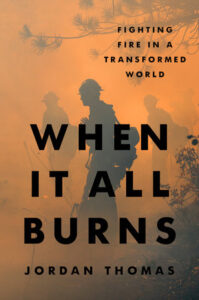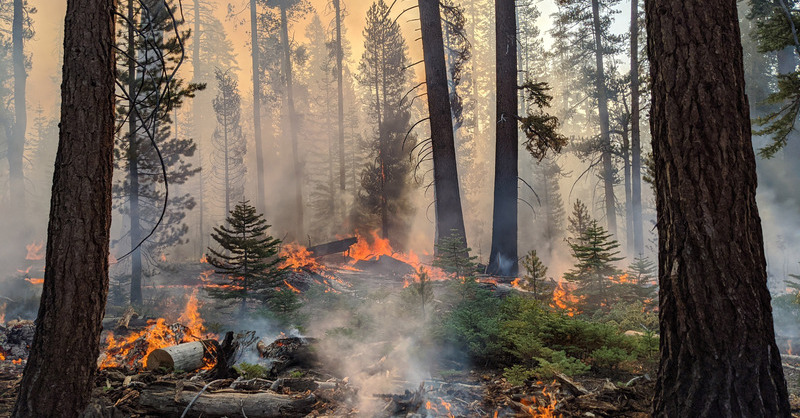Featured image: National Park Service
Article continues after advertisement
One afternoon in September 2021, as a megafire burned through Sequoia National Forest, my hotshot crew marched into a grove of its ancient trees. In the crisp air of high country, the sounds of creaking wood and swishing pine muted our footsteps. Sequoias towered through the smoke. Their canopy closed hundreds of feet above. We moved between trunks the size of cabins, the bark grooved and red. Small squads dropped off from our crew of twenty, spreading along the ridge to prepare for the megafire hurtling toward us.
My own group peeled off near the top of the ridge to await orders. After fighting this fire for the past week, my knees ached, my blisters stung, and my head hurt. I was tired. I knew the other hotshots felt the same. They were chewing tobacco and sharpening their tools—hybridized shovels, axes, and hoes with macho names: the Rogue, Pig, Chingadera. I set my chainsaw on the forest floor, removed my gloves, and, for the fifth time that day, pricked my thumb on the chain’s teeth to make sure they were sharp. The grove made me restless.
By holding the ridge, I felt we were holding back a new, altered world. As I waited on the fireline with ash in my lungs, I still hoped this was possible.
In the past two decades, wildfires have been doing things not even computer models can predict, environmental events that have scientists racking their brains for appropriately dystopian terminology: firenadoes, firestorms, gigafires, megafires. Scientists recently invented the term “megafire” to describe wildfires that behave in ways that would have been impossible just a generation ago, burning through winter, exploding in the night, and devastating landscapes historically impervious to incendiary destruction—like the sequoia groves of California. Sequoias are among the oldest organisms in existence, with fire‑resistant bark several feet thick and crowns that can recover when 90 percent is scorched. They even rely on fire to reproduce, as flames crack their cones so seedlings can germinate. Now, the same ecological force they once depended upon is pushing them toward extinction.
Sequoias’ lives are monuments of deep time. Their death would signify something else. If we could not hold this ridge against the megafire, the sequoias would become the largest torches on earth, carrying flames higher than the Statue of Liberty. After three thousand years of life, they would become charred monuments to a passing era, symbols of a violent future. By holding the ridge, I felt we were holding back a new, altered world. As I waited on the fireline with ash in my lungs, I still hoped this was possible.
A figure appeared through the smoke, huffing toward us. I stood, worried our superintendent, Aoki, the leader of the Los Padres Hotshots, would catch us sitting. I relaxed when I recognized Jackson.
“Jack!” someone called.
“What’s the word?” another asked.
“Fellas,” Jack greeted us, loosening his pack to catch his breath. His face and beard were caked in dirt. “Cancel your plans, boys. We’re gonna be up all night.” Word had traveled down the chain of command that we were going to burn our line that evening.
We had spent six days building that line, working from sunrise to sunset, cutting a path through brush and hills, up a mountain ridge into high timber and finally to an old logging road. Wildfires cannot burn without fuel—grass, bushes, and trees—and our line formed a fuel break, a continuous barrier of dirt that snaked around the megafire. When the conditions were right, we would set fire to its edges. The flames we lit would move toward the megafire and consume the fuel in its path. This is the fireline—a dirt band that holds fire back from the world.
Now, we only had a few hours before the megafire would hit us—a few hours to finish the line and set fire to the ridge.
“It’s gonna be a shitty burn,” Jack relayed. “We’ll be chasing spot fires all night.”
I asked if we had any safety zones, defensible spaces like meadows where we could survive if the fire got out of control.
Jack hedged, chewing the corner of his mustache. “There’re some bulldozers trying to plow one near the peak,” he said. “The thing is, we’ll be going downhill. So, if this thing gets away from us, we’ll need to run to our vehicles and get out of here.”
“It’s a forty‑five‑minute drive out of the forest,” I noted. “Yeah, hopefully we’ll get out.”
A radio crackled. Through the static came a gruff voice. Márlon was reporting from his lookout position. “The fire seems a little more extreme,” he said. “Three‑hundred‑foot flames coming at us.”
Aoki’s laughter cut into the radio traffic. “Hoookay! Let’s get the rest of the line pushed through and get that burn goin’.”
My group huddled in the trees in smoke and radio silence. We didn’t know where Aoki was or who he was telling to push the line. We often joked that he was a mountain spirit. Tall and willow thin, with black hair that fell to the small of his back, he moved with the smoke, drifting and reappearing through the trees. Aoki had turned fifty that season and was widely considered the most experienced hotshot in California—a state that claims the most skilled firefighters globally.
Now, the megafire was throwing embers ahead of its advance, starting smaller fires, spot fires, like raiding parties for an approaching army. Axel, a squad boss, called us toward one that was smoking in the valley below. If we let it grow, it would rush up and cross our line, igniting the forest behind us and trapping us in the path of the megafire. “If the fire gets behind us,” Axel said, “we’re fucked.”
In the ringing silence that follows a chainsaw’s scream, I realized that the silence was becoming a roar, and the roar came from the megafire.
Scrambling down loose rocks into the valley, we followed Axel’s shout and found the spot fire. It had grown to the size of a football field. We cut around it, choked with smoke. In the ringing silence that follows a chainsaw’s scream, I realized that the silence was becoming a roar, and the roar came from the megafire. It was close.
The dark understory of the forest began to glow, a vibration emanating from its depths, rising to the sound of a jet engine. The treetops groaned with wind created by the force of the megafire.
On the fireline, I rarely felt adrenaline. I experienced danger more as a pressure, a weight that never fully disappeared. As the danger grew, so did the weight. With the megafire roaring through the trees, I’d dropped my chainsaw and begun filing the saw’s teeth to new points. Now, the chainsaw shook in my hands.
“Listen.” Axel cocked his head with wild eyes and a feral grin. “You hear it? Let’s get out of here.”
Axel led our escape, men sweating as the moon rose like a counterweight to the setting sun. A radio crackled, Aoki warning that the fireline was no longer safe and we should hurry down the ridge to our vehicles. I shouted to Axel, several headlamps ahead, that we were throwing away the past week of work. “It’s part of the job,” Axel replied. “You’ll get used to it.” His reply evoked a hotshot adage: You learn to let go of hope, or you get crushed.
As we walked, our headlamps cast beams through clouds of smoke and dust, illuminating the trees around us like pillars supporting another world. Forced to retreat, I felt like we were abandoning that world. Just before reaching our vehicles, I stopped to look back at the megafire. It was a billowing column of shadow and light. Briefly, I doubted what I’d seen: through a gap in the trees, a lone flame rose and flickered above the rest.
Only a sequoia—a tree that had coexisted with fire for millennia— could carry flames so high.
__________________________________

From When It All Burns: Fighting Fire in a Transformed World by Jordan Thomas. Published on May 27, 2025 by Riverhead Books, an imprint of Penguin Publishing Group, a division of Penguin Random House LLC. Copyright © 2025 Jordan Thomas.
